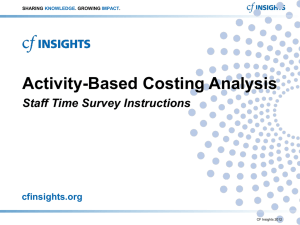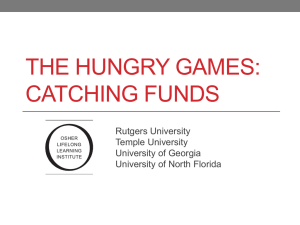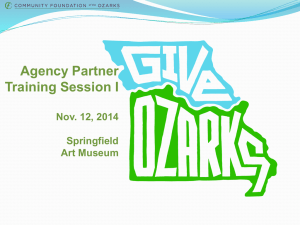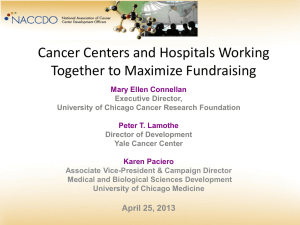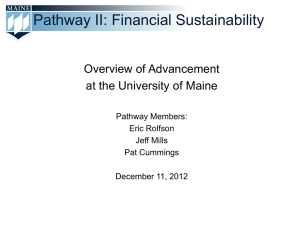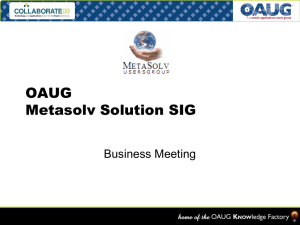How to Have a Financially Healthy Area Through TDS 101-201 8
advertisement
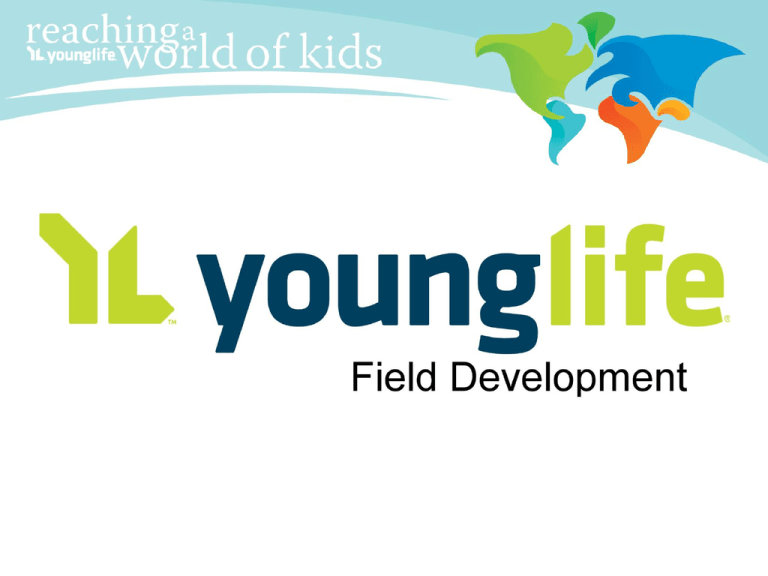
Reaching More Kids by Taking Donors Seriously™ TDS 101 My Family Why Raise Support? “Fundraising is as spiritual as giving a sermon, entering a time of prayer, visiting the sick, or feeding the hungry!” Henri Nouwen Describe how you currently feel about fundraising in your area Luke 8:1-3 8 After this, Jesus traveled about from one town and village to another, proclaiming the good news of the kingdom of God. The Twelve were with him, 2 and also some women who had been cured of evil spirits and diseases: Mary (called Magdalene) from whom seven demons had come out; 3 Joanna the wife of Chuza, the manager of Herod’s household; Susanna; and many others. These women were helping to support them out of their own means. T D S Doing what we Do with Kids, but with Adults Bringing the same relational quality and intentionality that anchors our work with kids to our work with adults! Young Life doesn’t have a money problem, Young Life has a communication problem. Bill Hautt, founder of TDS Adult Ownership The Big O Ownership Adult Ownership Who owns the funding in your area? Healthy Areas Have It! The 7 Essentials (Non-Negotiables) of TDS Prayer 1. • We not only recognize that it is within God’s power to fulfill all our needs, we also desire God’s wisdom and strength to carry out our responsibility in a way that ministers to all our donors. • Do you have a prayer strategy in your area that includes donors? Case Statement 2. • • A Presentation Tool, Not a Brochure Vision beyond what currently is happening Leadership (TDS Team) 3. • • Often Small Business Owners, Active Community People Can come from your top 30% of Donor Base (TDS Chairperson, TDS Askers, Data Manager, AD, Committee) Do you know (does your entire Committee know)? How much needs to be raised each month to keep your area on track? How much needs to still be raised before the end of the fiscal year (September – this month)? The 7 Essentials (Non-Negotiables) of TDS 4. Cash Flow Projects your area Budget 12 months into the future 2. Shows how changes in Revenue and Expenses will affect your area 3. Creates a one page summary of your area’s financial health 4. Helps get everyone one the same page with reality (faking financial health doesn’t work) 1. The 7 Essentials (Non-Negotiables) of TDS 5. Priority Prospect List (Online tool) 1. List of current, past and potential donors Answers the questions: How much is committed in cash and pledges? How much more needs to be raised? Does the best case scenario= 150% of what you need (the budget)? The 7 Essentials (Non-Negotiables) of TDS 6. Strategy • • 70/30 Rule of Fundraising The most effective way to raise money is to ask for it The Strategy The Importance of an Effective Approach The Attributes How many of these does the prospect have? The more the have the more likely they’ll give. Love kids Love Christ Love you Love YL Have a giving spirit Circles of Support What are some of the possible circles of support? 5 Ways to Raise Support Large Group Events Letters Phone Calls Small Group Events Face-to-Face Meetings Effective Strategy for Asking Getting people On the Team – Committee, TDS, etc. More People Saying “Yes” Spend 70% of Time/Effort in Top 3 Face-to-Face Small Group Large Group Phone Call Letter Spend 30% of Time/Effort in Bottom 3 Increased Gift Size The 7 Essentials (Non-Negotiables) of TDS 7. Financial Master Plan • • • A fancy way to say “calendar” Year long plan broken down by month as to how the area is going to the raise the budget Takes the strategy and breaks it out in practical month by month pieces Q&A What To Do If Finances Are Really Tight Update Cash Flow – get an honest assessment of what is needed and by when Get people praying for the area’s finances so the area can reach more kids Communicate with the Core Committee Top Donors – sit Face-to-Face with Top 20-30% of PPL and ask for their help/ask the Who question Parents – let then know how this thing works Leaders connections (appropriately) Get Top 3 asking strategies happening in the next 15-30 days Look for Top 20-30% donor who could put up matching money Talk to Regional Team Talk to Field Development Director Dynamics of Great TDS People experience God’s blessing in helping to grow His kingdom. Relationships are built and deepened. Donors are enabled to meet specific needs and thereby blessed! Donors feel that they are a part of the team and that this is ‘their’ ministry. Not only are kids’ lives changed but adults’ lives are changed as well. Resources TDS Manual Field Development Website - http://staff.younglife.org/FieldDevelopment Other successful Committees Regional Team Contact InfoGreg Lehman Divisional Field Development Director glehman@sc.younglife.org 937-286-9954 Taking Donors (even more) Seriously™ TDS 201 My Family Donor Retention Reality Areas currently retain 65% of donors Donor retention for monthly online donors is 90% Offline retention rate hovers around 50% What does this tell us? This Tells Us That The Way We Approach Donor Work Really Matters Transactional vs. Transformational Transactional • • • Transaction - You give me a gift, I thank You and talk with you next year. Transformational • • • Invite them onto the team and they will be transformed. Ask donors for involvement beyond giving (Prayer, Table Host, Committee, Club Support, etc.) Communicate throughout the year in ways that keep them close to the ministry. Get them close to the fire! Get them to a Club, a Weekend, or Camp as an Adult Guest. How Do We Become Transformational? What does TDS look like in an area? • A regularly meeting of a group of likeminded people who want to see Young Life on a solid financial ground. • The group looks into the future and is able to project financial needs. • A group of people who are not afraid of money and who are bold with people. TDS Team Roles Area Director/Staff Prepares the case statement Ensures the PPL and Cash Flow are being updated Personally knows the top 10 – 12 donors in the area Builds teams: TDS, banquet, golf, etc. Coordinates communication of confidential donor information to TDS team. TDS Team Roles TDS Chair Partners with the area director in the above Holds face-to-face askers accountable for doing major donor visits Owns 3-8 major donor relationships Insures execution of strategies to raise budget Data/Finance Manager Maintains PPL master list (and possibly Cash Flow) Prints out banquet invitation lists, phone-a-thon lists, face-to-face lists Identifies lapsed donors Communicates information to appropriate team members TDS Askers Review lapsed donor list annually Have relationships with major donors that win the right to ask Make 3 – 4 major donor asks yearly (2 times thank you, 1 time ask) Brainstorm new names for PPL annually Young Life Committee “Owns” the banquet Do major donor thank you visits and write thank you’s Conducts the phone-a-thon Best TDS Teams are: • Not just the main committee • Tend to be business/business minded people • Which means they might meet over breakfast/lunch. • People who may have been on other non-Young Life committees or boards. • Have experienced financial campaigns or terms of office. • Who see TDS as a ministry. • Divide up roles. • i.e. Foundations, golf, treasurer… How to Make TDS Succeed in Your Area • Area Director/Staff needs to partner with this group. • Scripture, sharing, prayer • Needs to be lead by a non-Young Life staff person – the TDS Chair. • Needs to have strong accountability by the TDS Chair. • Needs to be focused around “Asking” and deepening relationship with donors. To Grow Support Build a Team of… 3 Askers… Making 2 Asks Per Month… 10 Months a Year! To get people on the TDS Pray Team… Create a list Look at key donors Ask around the community Ask-Be bold, use the case Make specific, personal asks. Lay out a clear role for them to serve in. Clearly share the vision of why they are so important to the mission of reaching kids. Center the group around Askers. Effective Strategy for Asking Getting people On the Team – Committee, TDS, etc. More People Saying “Yes” Spend 70% of Time/Effort in Top 3 Face-to-Face Small Group Large Group Phone Call Letter Spend 30% of Time/Effort in Bottom 3 Increased Gift Size Entry Points What are the entry points for adults into Young Life? Successful areas create entry points throughout the year for adults The most successful areas understand that the best entry point is a person! TDS member Committee person Current donor Finding New Donors Through current donors. The question that should constantly be on our lips: “Who else should we share this with?” Characteristics to look for: Heart for kids Giving lifestyle Passion to follow Christ Other places to look: Parents of kids involved (talk to team leaders) Connected community people (i.e. highly involved in churches, schools, healthy civic groups, local businesses, successful realtors and sales people, etc.) Increasing Monthly Donors Working with the Top 20-30% People Give Because They’re Asked and Shown How We often make two mistakes when we ask people for money: We go to them and give them an assortment of choices of gift sizes – from very small amounts to very large amounts this is confusing and makes a decision difficult We don’t suggest when and how we would like to receive the gift. Long term we should know our donor well enough to ask for the size gift that they are capable of giving and suggest a method that fits their situation. “Top 3 Principle” Difference from 2005 to now: 2005 – people were giving to their top 7 charities Present – people are giving giving to their top 3 charities Invitational Asking Would you rather be asked for something or invited to something? Donors need to feel like they are a part of the great work that is going on in the lives of kids! Giving Styles Telling the Story Discussion What is the story? What is unique about the Young Life story? What must we make sure that we communicate? How Do We Continue to Tell the Story? The Importance of Story How is your area telling the story of kids and Christ… Deeper Discussion and Q&A John 6:1-15 The Feeding of 5000 Resources TDS Manual Field Development Website - http://staff.younglife.org/FieldDevelopment Other successful Committees Regional Team Contact Info Greg Lehman Divisional Field Development Director glehman@sc.younglife.org 937-286-9954 The Ask The Ask 1. The Invitation Who is making it and setting the right expectation. 2. Preparation Right attitude Know and prep The Case 3. The Meeting Listening Telling the story Asking the Question 4. Follow Up Thank within 48 hours Make it easy for them to give the gift Continue and deepen the relationship Invitational Asking Would you rather be asked for something or invited to something? Donors need to feel like they are a part of the great work that is going on in the lives of kids! People Give Because They’re Asked and Shown How We often make two mistakes when we ask people for money: We go to them and give them an assortment of choices of gift sizes – from very small amounts to very large amounts this is confusing and makes a decision difficult We don’t suggest when and how we would like to receive the gift. We should know our donor well enough to ask for the size gift that they are capable of giving and suggest a method that fits their situation. One Important Step 3 Askers 2 Asks Per Month 10 Months a Year Financial Master Plan Where Strategy Gets Lived Out in a Calendar FMP Handout Example God is Able “Now to him who is able to do immeasurably more than all we ask or imagine, according to his power that is at work within us, to him be glory in the church and in Christ Jesus throughout all generations, for ever and ever! Amen.” Eph 3:20 Donor Retention Reality Areas currently retain 65% of donors Donor retention for monthly online donors is 90% Offline retention rate hovers around 50% What does this tell us? This Tells Us What We Are Doing with Donors Really Matters Thanking Donors – The Power of Appreciation How do you like to be thanked? What makes you feel appreciated? Ways to Thank Donors Face-to-face Handwritten Notes Quarterly Thank You Notes from the Service Center Phone Calls Letters Appreciation Events Other Creative Ideas Key: Connect the donors giving to the lives of kids! Women in Fundraising Did you know: Women control two-thirds of all wealth in the U.S. Women make 80% of all household purchasing decisions. Women give more to non-profits than men do. Women are often connectors and twice as likely to pass information on about your cause. Resources TDS Manual Field Development Website - http://staff.younglife.org/FieldDevelopment Other successful Committees Regional Team Contact Info Greg Lehman Divisional Field Development Director glehman@sc.younglife.org 937-286-9954 Resources TDS Manual Field Development Website - http://staff.younglife.org/FieldDevelopment Other successful Committees Regional Team Contact InfoGreg Lehman Divisional Field Development Director glehman@sc.younglife.org 937-286-9954 Q&A The End Herding Cats Extra Slides Ask Clearly and Thank Well The Importance of Story How is your area telling the stories of kids and Christ… The Big Question Successful Areas Are Asking Who else could we share Young Life with and invite to be a part of this? Committee Must Subscribe to Basics Committee owns the ministry You will be here long after current staff moves on Committee needs to build the relationships that make the area ministry possible and guarantee its future Every member of the committee needs to be doing TDS on some level • It’s relational! • It’s challenging! • It’s rewarding! More Than Money I Timothy 6:17-19 17Command those who are rich in this present world not to be arrogant nor to put their hope in wealth, which is so uncertain, but to put their hope in God, who richly provides us with everything for our enjoyment. 18Command them to do good, to be rich in good deeds, and to be generous and willing to share. 19In this way they will lay up treasure for themselves as a firm foundation for the coming age, so that they may take hold of the life that is truly life. Entry Points What are the entry points for adults into Young Life? Successful areas create entry points throughout the year for adults The most successful areas understand that the best entry point is a person! TDS member Committee person Current donor Adult Ownership The Big O Ownership Adult Ownership Who owns the funding in your area? Healthy Areas Have It! Dynamics of Great TDS People experience God’s blessing in helping to grow His kingdom. Relationships are built and deepened. Donors are enabled to meet specific needs and thereby blessed! Donors feel that they are a part of the team and that this is ‘their’ ministry. Not only are kids’ lives changed but adults’ lives are changed as well. Transactional vs. Transformational Transactional • • • Transaction - You give me a gift, I thank You and talk with you next year. Transformational • • • Invite them onto the team and they will be transformed. Ask donors for involvement beyond giving (Prayer, Table Host, Committee, Club Support, etc.) Communicate throughout the year in ways that keep them close to the ministry. Get them close to the fire! Get them to a Club, a Weekend, or Camp as an Adult Guest. Who do you currently ask for support? Circles of Support What are some of the possible circles of support? Connecting the Circles What connects these circles back to the ministry? The ASKER Who are your Askers? Who could be your Askers? Finding New Donors Through current donors. The question that should constantly be on our lips: “Who else should we share this with?” Characteristics to look for: Heart for kids Giving lifestyle Passion to follow Christ Other places to look: Parents of kids involved (talk to team leaders) Connected community people (i.e. highly involved in churches, schools, healthy civic groups, local businesses, successful realtors and sales people, etc.) Invitational Asking Would you rather be asked for something or invited to something? Donors need to feel like they are a part of the great work that is going on in the lives of kids! Finish with Luke 8:1-3 or John 6:1-15 Q&A Deeper Donor Work Through Great TDS and a Great TDS Team God is Able “Now to him who is able to do immeasurably more than all we ask or imagine, according to his power that is at work within us, to him be glory in the church and in Christ Jesus throughout all generations, for ever and ever! Amen.” Eph 3:20 OCTOBER Annual fund-raising banquet (plan to raise the last 12 to 20 percent of budget). Meet with #1 donors to thank them for supporting the area. Confirm and/or revise pledges for year not yet fulfilled. Letter /Newsletter to everyone on PPL with update on ministry. NOVEMBER Meet with and cultivate #4s who attended the banquet and explore their interest in giving prior to Dec. 31. Letter/Phone follow-up for #2 and #3 donors who didn’t attend the banquet, or who attended but didn’t make a commitment. Meet with #1 donors not available in October to thank them for supporting the area. Year End Appeal and Holiday newsletter. DECEMBER Have Campaigner kids call key donors they know to thank them for making Young Life a reality and wish them a Merry Christmas. Year End Appeal face-to-face meetings and phone calls. Send Christmas cards. Plan • Complete a Strategy and Timeline (Financial Master Plan) • Manage your List (PPL) • Start Now! Building a Great TDS Team What does TDS look like in an area? • A regularly meeting of a group of likeminded people who want to see Young Life on a solid financial ground. • The group looks into the future and is able to project financial needs. • A group of people who are not afraid of money and who are bold with people. TDS Team Roles Area Director Prepares the case statement. Prepares the FDT and data. Personally knows the top 10–12 donors in the area. Builds teams: TDS, banquet, golf, etc. Coordinates communication of confidential donor information to TDS team. TDS Chair Partners with the area director in the above. Holds face-to-face askers accountable for doing major donor visits. Data/Finance Manager Maintains PPL. Prints out banquet invitation lists, phone-a-thon lists, faceto-face lists. Identifies lapsed donors. TDS Askers Review lapsed donor list annually. Create and maintain relationships with major donors that win the right to ask. Make three to four major donor requests yearly. Brainstorm new names for PPL annually. Young Life Committee “Owns” the banquet. Does major donor thank you visits. Conducts the phone-a-thon. Best TDS Teams are: • Not just the main committee • Tend to be business/business minded people • Which means they might meet over lunch. • People who have been on other non-Young Life committees or boards. • i.e. United Way, YMCA, etc. • Have financial campaigns or terms of office. • Who see TDS as a ministry. • Divide up roles. • i.e. Foundations, golf, treasurer… How to Make TDS Succeed in Your Area • Area Director needs to partner with this group. • Scripture, sharing, prayer • Needs to be lead by a non-Young Life staff person – TDS Chair. • Needs to have strong accountability by the TDS Chair. Principle: We Have Not Because We Ask Not We are afraid to ask people to help "Ask and it will be given to you; seek and you will find; knock and the door will be opened to you. For everyone who asks receives; he who seeks finds; and to him who knocks, the door will be opened.” Matt 7:7-8 NIV Remember Pray Create a list Look at key donors Ask around the community Ask-Be bold, use the case Make specific, personal asks. Lay out a clear role for them to serve in. Clearly share the vision of why they are so important to the mission of reaching kids. Center the group around Askers. Thanking Well Thanking and funding go together! Thanking sets up asking. How do we thank donors well? How do you like to be thanked? Women in Fundraising Did you know: Women control two-thirds of all wealth in the U.S. Women make 80% of all household purchasing decisions. Women give more to non-profits than men do. Women are often connectors and twice as likely to pass information on about your cause. Development in YL 1. Field Development Department Helping areas to be financially healthy so they reach more kids Coaching & Conference Calls 1. 2. 1. 2. 3. 4. 3. 4. Cash Flow & PPL Training Calls Deficit and Reduced Salary Calls Financial Watch Calls Emma Best Practices Calls Best Practice Emma Newsletter Website 2. Grants and Foundation Office 3. Gift Planning Contact Info Greg Lehman Southern and Eastern Divisions 937-286-9954 glehman@sc.younglife.org Q&A Time Extra Slides Growing Raising ministry support is one of the greatest opportunities to grow in your faith and to help others respond to God’s call to build His kingdom. Philippians 4:10 – “I rejoice greatly in the Lord that at last you have renewed your concern for me. Indeed, you have been concerned, but you had no opportunity to show it.” Philippians 4:14-20 – “14 Yet it was good of you to share in my troubles. 15 Moreover, as you Philippians know, in the early days of your acquaintance with the gospel, when I set out from Macedonia, not one church shared with me in the matter of giving and receiving, except you only; 16 for even when I was in Thessalonica, you sent me aid more than once when I was in need. 17 Not that I desire your gifts; what I desire is that more be credited to your account. 18 I have received full payment and have more than enough. I am amply supplied, now that I have received from Epaphroditus the gifts you sent. They are a fragrant offering, an acceptable sacrifice, pleasing to God. 19 And my God will meet all your needs according to the riches of his glory in Christ Jesus. 20 To our God and Father be glory for ever and ever. Amen.” Discuss What is your biggest fear in raising support? What currently is your biggest challenge? Namestorming 2 Relatives 2 Christian Friends 2 Past/Current Co-Workers 2 Past/Current Neighbors 2 People You’ve Been in a Bible Study With 2 People You Know Who Have Taken Mission Trips 2 Church Members 2 People You’ve Sent Christmas Cards To 2 Past Employers/Employees Your Doctor and Your Dentist Namestorming Think through specific periods of your life: 2 People You Went To Elementary School With 2 People You Went to High School With 2 People You Went to College With If you’re married, people in your wedding party and people who came to your wedding People You Invited/Will Invite to Your 40th Birthday Party The Referral (“Introductions”) After asking for financial support ask, “If you were in my shoes who would you talk to.” Don’t ask them to qualify the names. Ask them if they would consider giving you an introduction through an email or phone call. Even better if the will set up the meeting and be there with you. Not everyone will give you referrals but ask everyone. Contact the referrals promptly. Thank people for their help! Breakout Groups What is something that has worked for you/your ministry in raising support? What is something that God has brought to your attention so far today that you need to focus on in raising support? What is one prayer request in regards to raising support that others can pray for? Go around the circle/group and pray for one another! Financial Master Plan What is it? A fancy way to say Calendar Breaks down the fundraising plan month by month Keeps the team on the same page by answering the question: What are we doing this month to care for donors, ask donors for support, and thank donors? Thanking Well Thanking and funding go together! Thanking sets up asking. How do we thank donors well? How do you like to be thanked? Challenge What are two things regarding support raising that you need to take action on when you return home? What step of faith does God want you to take in raising support? Q&A Time The Tools Young Life’s Taking Donors Seriously System The Online Priority Prospect List The Online Cash Flow The Field Development Website What To Do If Finances Are Really Tight Update Cash Flow – get an honest assessment of what is needed and by when Get people praying for the area’s finances so the area can reach more kids Communicate with the Core Committee Top Donors – sit Face-to-Face with Top 20-30% of PPL and ask for their help/ask the Who question Parents – let then know how this thing works Leaders connections (appropriately) Get Top 3 asking strategies happening in the next 15-30 days Look for Top 20-30% donor who could put up matching money Talk to Regional Team Talk to Field Development Director The Ask The Ask 1. The Invitation Who is making it and setting the right expectation. 2. Preparation Right attitude Know and prep The Case 3. The Meeting Listening Telling the story Asking the Question 4. Follow Up Thank within 48 hours Make it easy for them to give the gift Continue and deepen the relationship Thanking Donors HOW TO THANK DONORS Compiled List from Areas Around the Country Sent a blanket to a $50,000 donor "'This is what a $50,000 blanket looks like" OH At Christmas take kids to deliver YL blankets to top 30 donors PA Pray IA Constant contact - newsletter, small gifts, gift cards VA GA Notes from kids at camp VA MA CT Group photo of kids at camp and made post cards MA Camp picture - put note at bottom and put in magnet sleeve (CHEAP) CT Write personal thank you notes VA Top 40-50 donors get a written note once or twice a year VA Post cards from any trips taken (new staff training, etc.) more personal donors VA Campaigner kids are given an example and they use it to write 2-3 thank yous each (great response from recipients) VA Hand deliver hand written notes GA Take pictures of kids, put in nice engraved frame with logo on it CA Made cards that had a collage on the front of the kids - with a thank you note inside written by the kids TX VA Put testimony from kids in the newsletter VA Special thank you section in one of our newsletters VA One thank you card from a committee upon receipt of check or money (get a person or two that wants to make this their job) Montly donors only get one 2-3 times a year VA Special thank you section in one of our newsletters VA A general thank you letter from the committee confirming pledge after the banquet, signed with a note VA Committee lady handwrites thank you notes to every donor every month OH $300 a year thank 7 times calendar…everybody on committee had a person to thank all 7 times they are responsible for being contact person for that person NH Poinsettias at Christmas time hand delivered to top 25 donors VA Hand deliver Christmas gifts by leader and a kid (homemade Chai, ornament etc.) A lot of donors welcomed them in to chat VA Made a local calendar with pictures of kids and sent to top 300 donors TX Have kids deliver cookie trays CA Christmas cards to everyone - a leadership christmas picture from Wal-mart VA Some don't send Christmas cards because they already receive so many Hand deliver a gift on Valentine's day KS We took 50 dozen cookies to our top businesses and top donors just to say thank you VA We Sent out Valentine's - 'thanks for loving kids' VA Bring them baskets with candy and a picture of the kids with a thank you on the back IA WA Hand deliver bread (big impact) TX Regional - deliver cherries to donors CA End of fiscal year (September) send a gift of $5 or less (book, cd, picture of kids in a frame) NJ Give YL "thank you" coffee mugs [where the "thank you" shows up after you fill w/something hot] VA Give small tin of YL-staff-homemade chocolate covered pretzels VA Something in donors hands every month - rubber bracelets..kids going to camp put on as a reminder to pray Important people remember birthdays & anniversaries Big auction fundraiser - don't spend money..make something personal 2 dozen assorted cookies CA Committee - took a percentage of donors and delivered something everyday for 1 week cookies, movie tickets (resources of the committee) People were blown away! Personal knocks from 7 different people in a row IN Invite them to personal events such as bowl-a-thon, dodge ball tournament, etc IL Make it a point to get together with donors on a regular basis VA Contact work with key donors (personal lunch goes a long Briefly Discuss When you hear the word ‘fundraising’ what comes to mind? What do you think when I say.. Fundraising “A necessary but unpleasant activity to support spiritual things...” “Fund Raising is proclaiming what you believe in and proclaiming it in such a way that you offer the other person an opportunity to participate in your vision” Young Life doesn’t have a money problem, Young Life has a communication problem. Bill Hautt, founder of TDS Effective Strategy for Asking Getting people On the Team – Committee, TDS, etc. More People Saying “Yes” Spend 70% of Time/Effort in Top 3 Face-to-Face Small Group Large Group Phone Call Letter Spend 30% of Time/Effort in Bottom 3 Increased Gift Size Oversimplified Fundraising Meet w/ Top 40 Donors before Banquet Spring Golf Event Camp Have Money Raised by Dec. Have a Fall Banquet End of the Year/ Follow Up Seven Steps in a Donor Gift Cycle Reporting & Follow-Up Identify Research & Evaluation Thank You Cultivation & Communication Ask Involvement Goals: Better equipped to reach more kids for Christ Be Encouraged Have long term healthy ministry, staff, committee and donors Grow in our own walks with Christ! Describe how you currently feel about fundraising in your area Evaluating Prospects: The Big Three • How are they connected to you and/or Young Life? • What's their financial situation? • Are they "givers"? “Fundraising is as spiritual as giving a sermon, entering a time of prayer, visiting the sick, or feeding the hungry!” Henri Nouwen The Way Young Life Traditionally Raises Money Stage 1: The October Banquet 278 People Attend the Banquet $57, 395 of the $133K budget is raised/ pledged Stage 2: The End of the year letter Money Keeps Coming in from Banquet Follow Up End of the Year Letter (with envelope) Revenue for area by end of Jan is $64K (2M+) Stage 3: Run Out of Money in April Feb and March are slow with $14K given total (3k church gift) Expenses do not slow down spending $26K (1M+) April BAD only $2700 revenue April Expenses are $11,300, area is -$1800 Stage 4: Golf Event in Late May Sponsors $16K Players $20K Expenses 6K Clear $30K May Revenue was 14K (Some Golf $$) May Expenses were $12K ($0 balance) Stage 5: Run out of money in July May and June were bolstered by the golf money. June is just above $2,000 (.2M ahead). July expenses are about $16,000 July revenue is $1,300 (Area is –13K, -1.1M) Stage 6: The Staff Goes on Reduced Salary Aug- the area director receives a 75% Grace Letter Sept- the Staff person goes on 75% reduce pay The committee wants to see something happen, but the next banquet is only a month away, and it feels wrong to ask people for help now and expect those same people to give at the banquet. Problems with the Treadmill: The focus was on events instead of relationships. There wasn't a clear plan to raise the area's budget. No strategy was used - every donor was given the same effort regardless of their ability to give. Responsibilities were not clearly defined. Too much stress and pressure was put on one event the banquet. The most effective way to raise money - through face to face meetings was not used!
